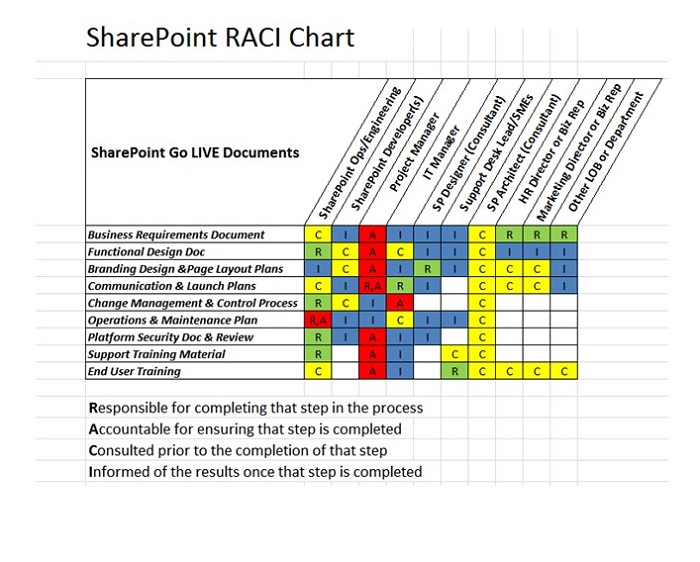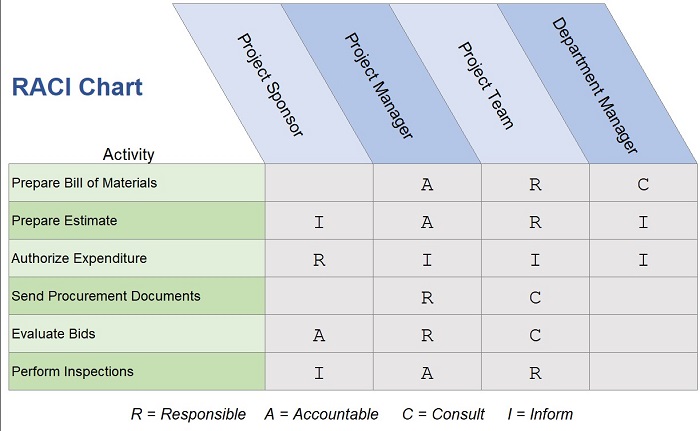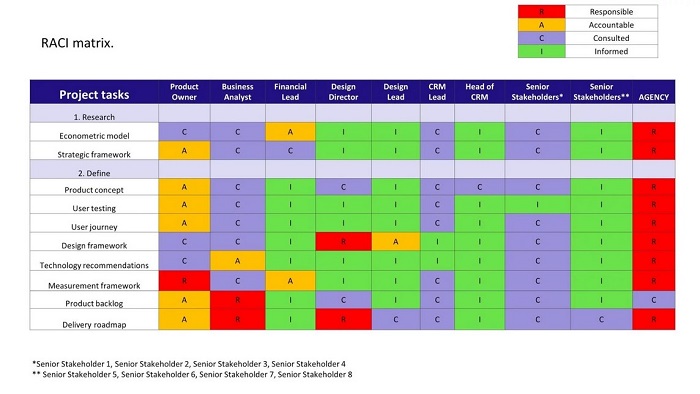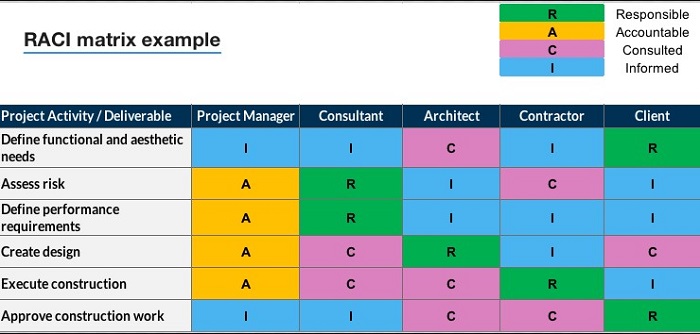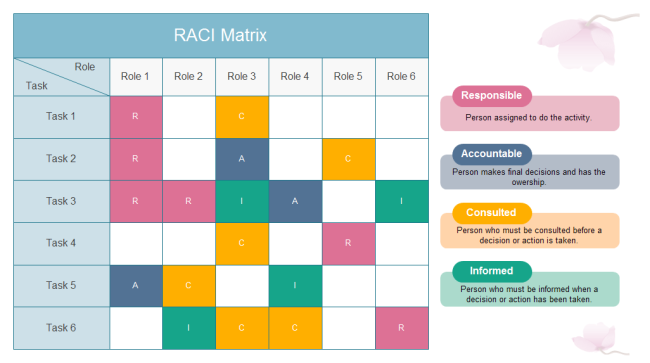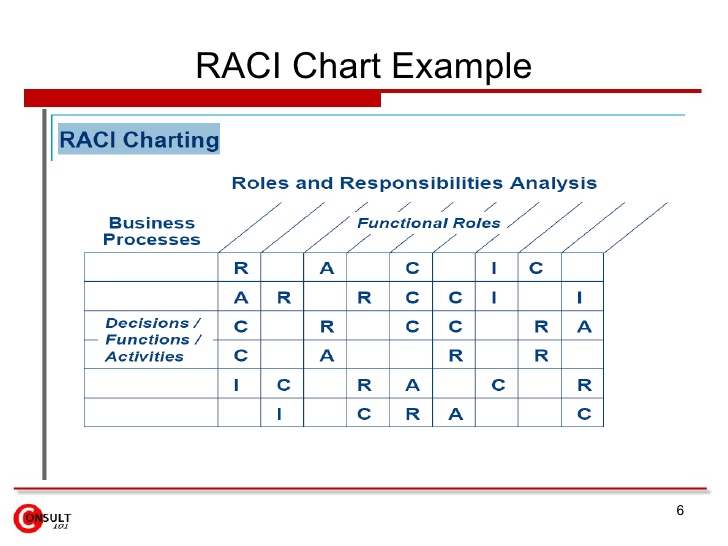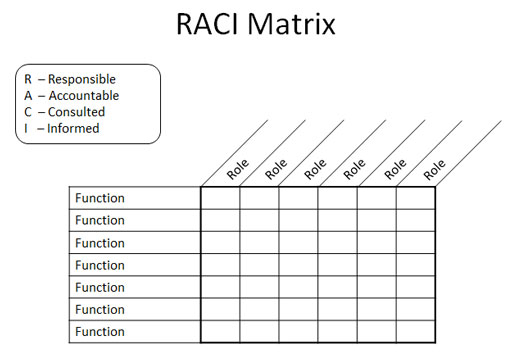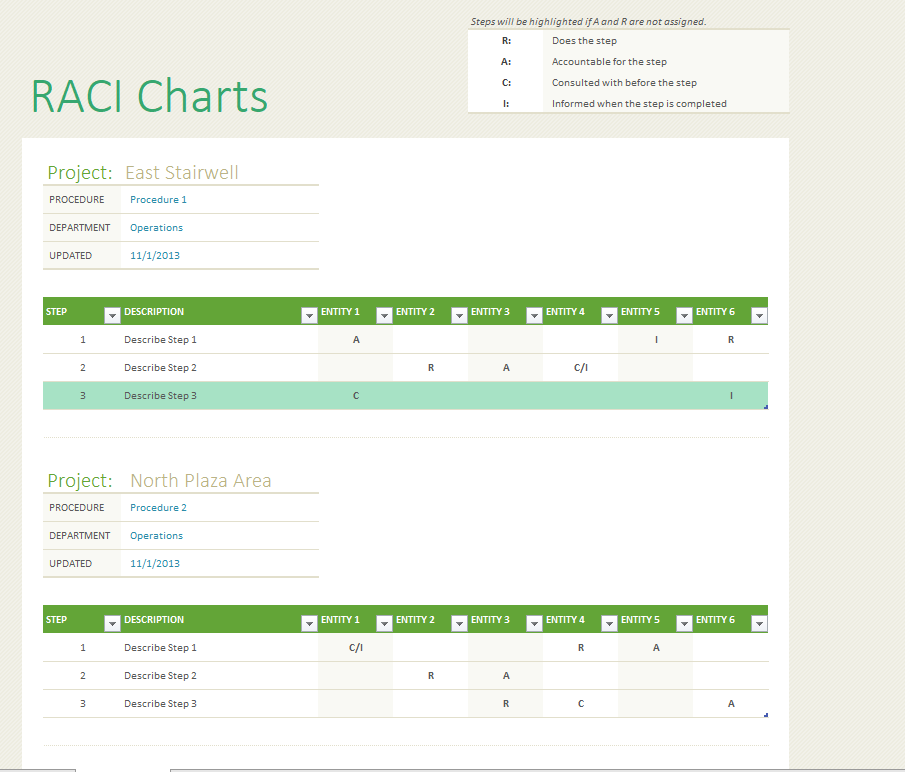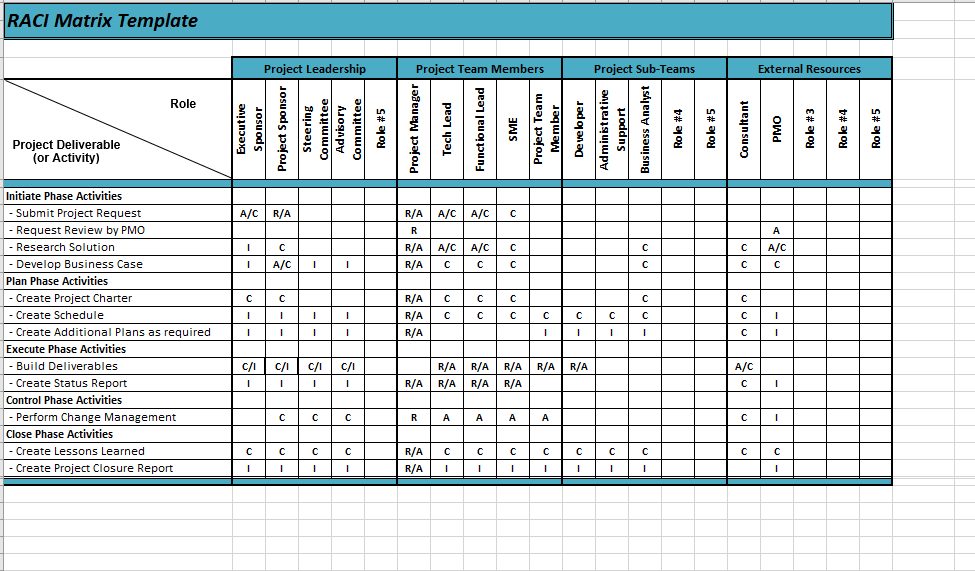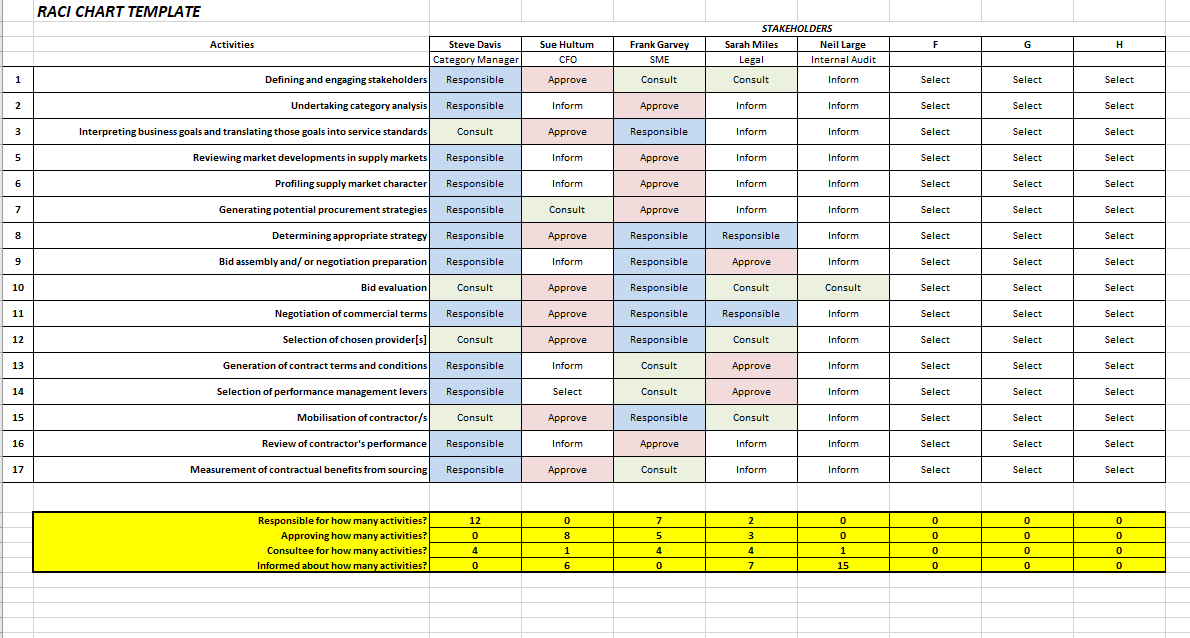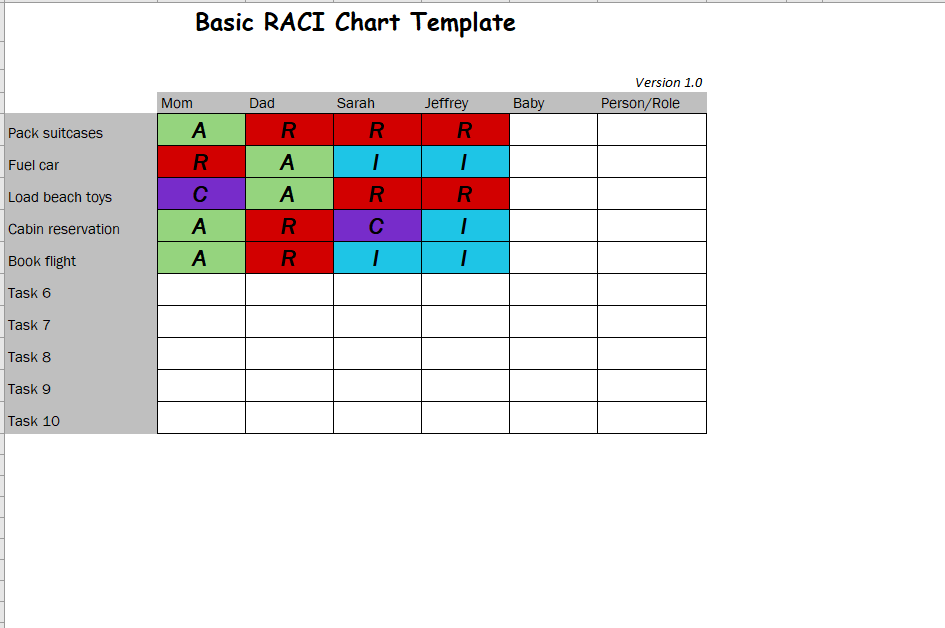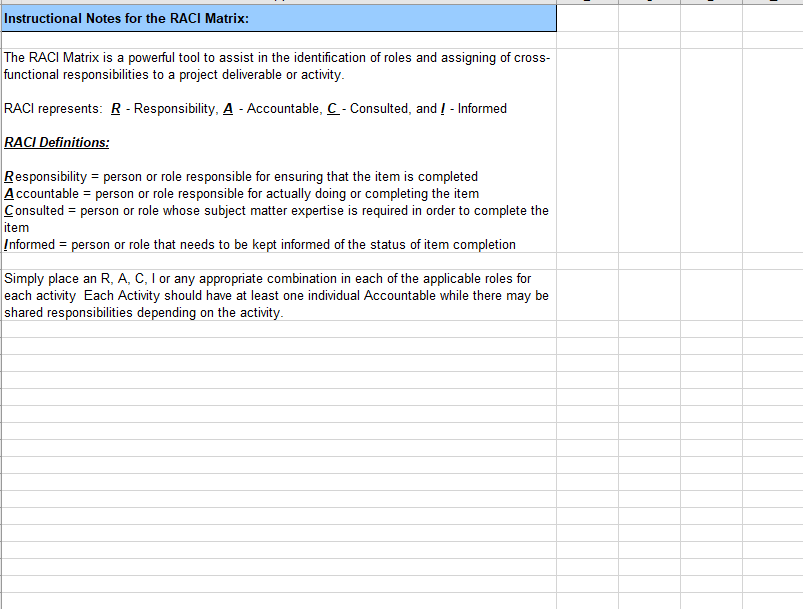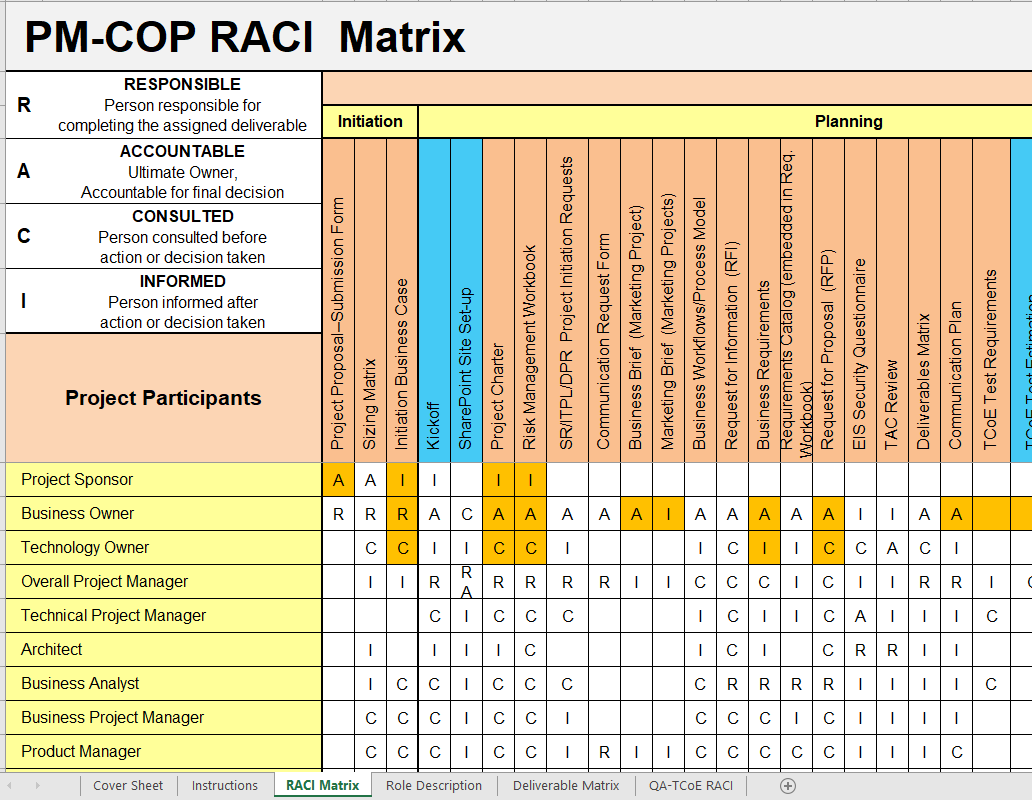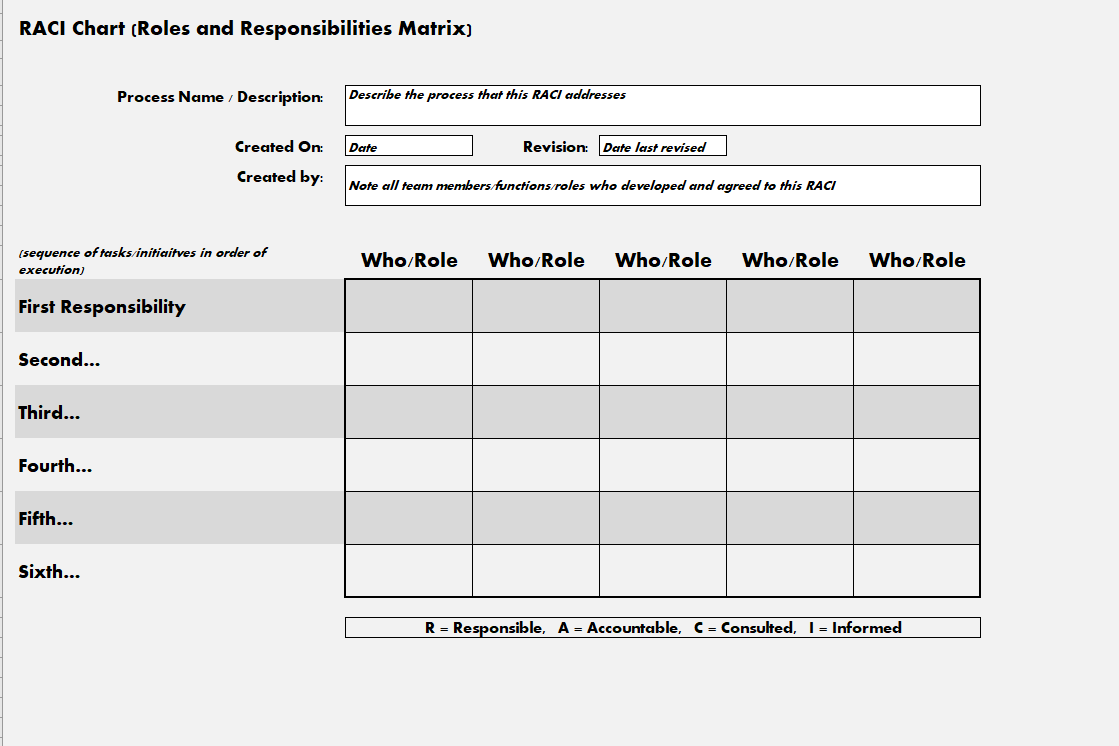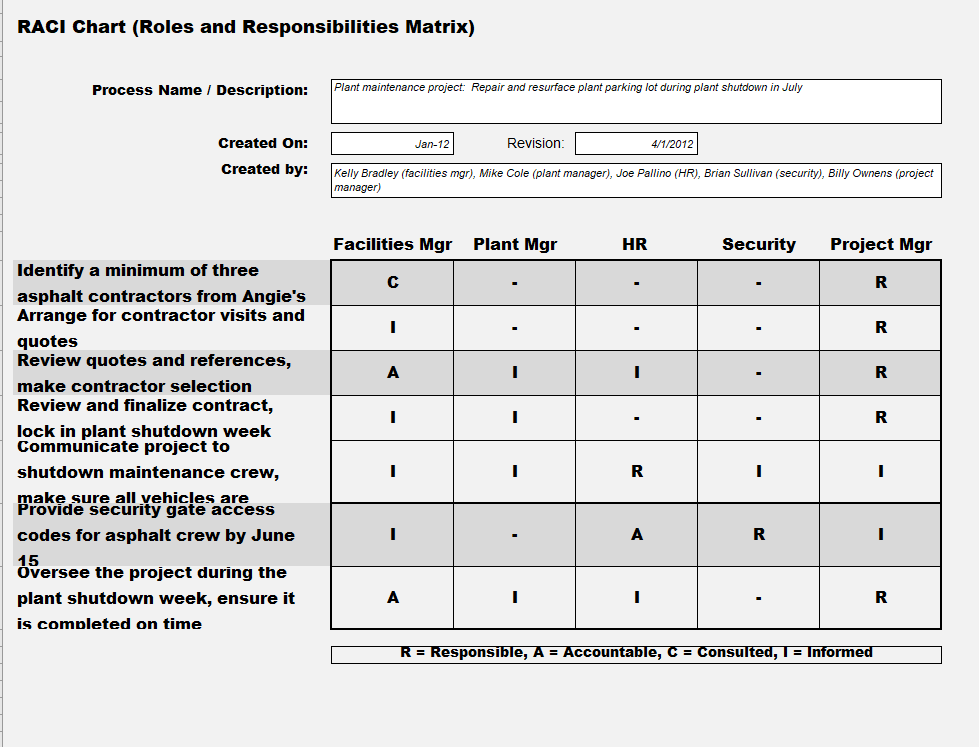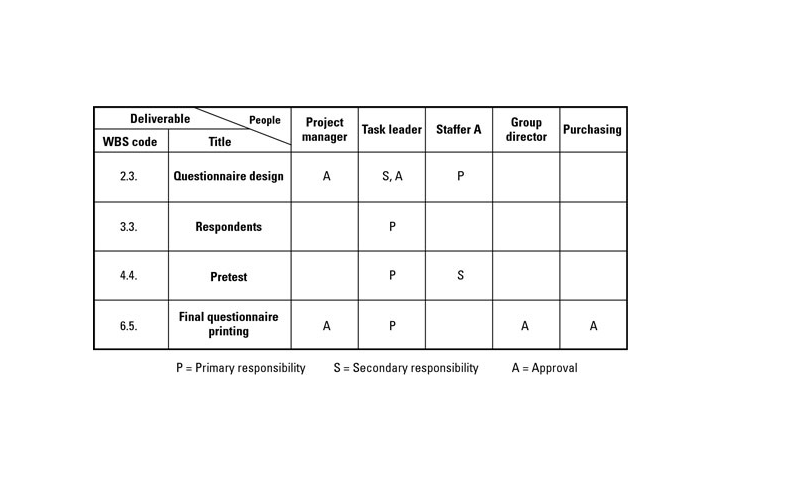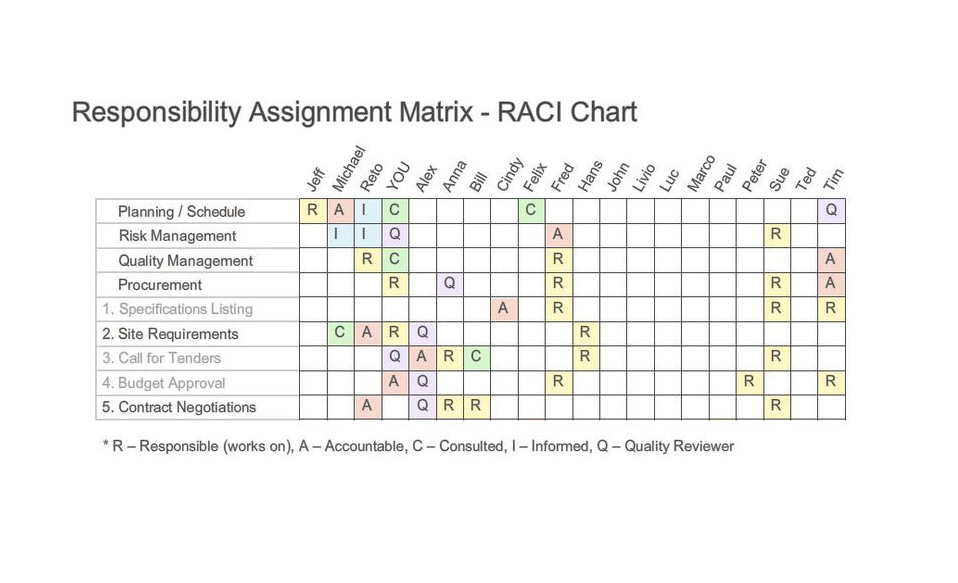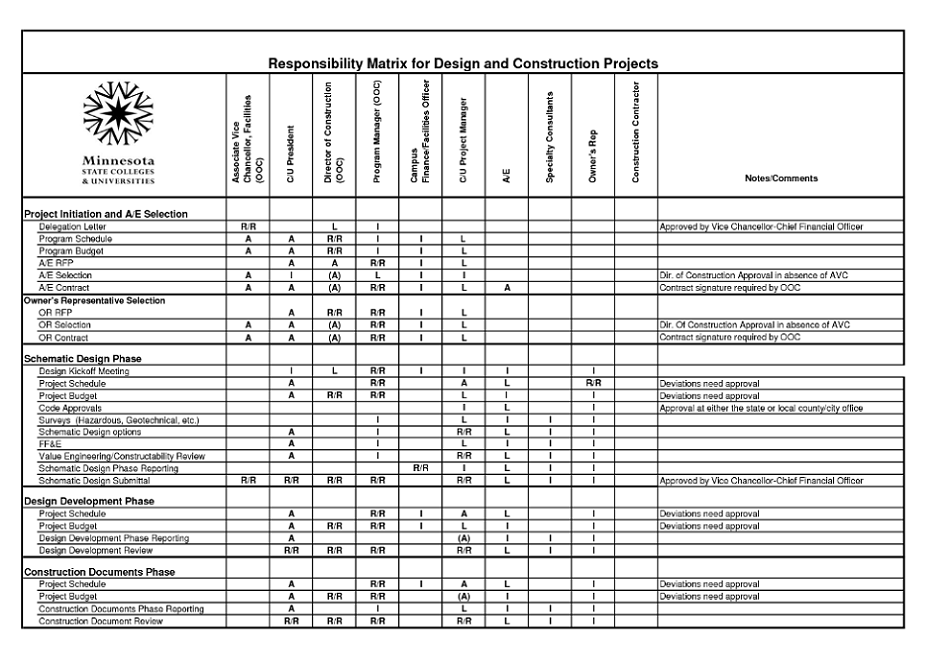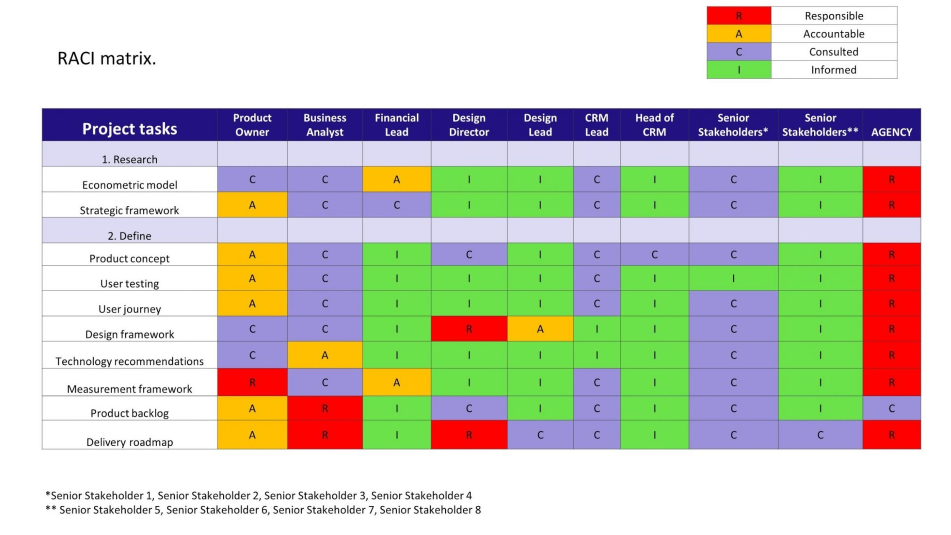What is the RACI chart? RACI stands for Responsible, Accountable, Consulted, and Informed. The method of RACI is commonly presented in the form of Matrix Chart so that it is also known as the RACI Chart. In a company or organization, RACI chart is a tool to use to make a decision and help to manage and identify the roles and responsibilities of the workers. Sure, it is because, in the chart, there are descriptions of a clear division of tasks.
The Aspects of the RACI chart
The RACI chart, an integral tool in project management, comprises four main elements or aspects. These categories are labeled as Responsible, Accountable, Consulted, and Informed. Each aspect serves a distinct function in project implementation and management.
- Responsible:This category signifies those who will carry out the task. These individuals or groups ensure that an action is completed successfully. They are the ‘doers’ in the project, actively working on the tasks and ensuring their completion.
- Accountable:This category refers to those who hold ownership of the task. It is ultimately answerable for the correct and thorough completion of the task. While multiple individuals may be ‘Responsible,’ there should only be one ‘Accountable’ individual to avoid confusion. The ‘Accountable’ individual is the one who signs off on the work before it’s deemed complete.
- Consulted:The Consulted group comprises subject matter experts who provide insights and advice related to the project. They don’t directly work on tasks but provide valuable guidance to ensure the work is executed correctly and efficiently. Their input typically sought before making decisions or implementing actions, can significantly enhance the project’s workflow.
- Informed:This last category comprises those who need to be kept in the loop about decisions and actions but do not necessarily participate in decision-making or task distribution. They need to be updated about the progress and outcomes of the tasks. Keeping the ‘Informed’ group updated ensures transparency and enhances overall communication within the project.
Understanding the roles and responsibilities attached to these aspects in the RACI model is crucial for successful project execution. It helps eliminate ambiguity regarding responsibilities, enhances coordination among team members, and, ultimately, aids in delivering a successful project outcome.
The Steps of Creating RACI chart
The manual creation of a RACI chart involves four main steps that revolve around the four indicators of the model: Responsible, Accountable, Consulted, and Informed. Below, we delve into a more detailed understanding of these steps:
- Identify the Processes and Functions of the Tasks
The first step in creating a RACI chart is understanding the project scope. It involves identifying the various processes and functions needed to address the problems.
You start by breaking down the project into its tasks or components, considering every action that must be completed for the successful completion of the project. It will give you a comprehensive overview of what requires to be accomplished, and it’s the foundational layer of your RACI chart.
- Identify the Roles, Tasks, and the People Required
Once you’ve mapped out all tasks, the next step is setting functions and recognizing the people most equipped to execute them.
You should categorize the tasks based on their nature and complexity and match them to the skills and competencies of your group partners. This way, you ensure that each individual is given a role that aligns with their expertise and experience.
- Determining the Key Players
The third step involves the management stepping in to officially designate someone to the functions and duties that have been identified. It’s a critical juncture where the management asserts its authority to make final decisions.
They analyze the team’s composition and consider the strategic implications of their choices. Balancing skills and capabilities across the task and adequately filling all required roles is essential.
- Assigning the RACI Categories
The final step in creating a RACI chart involves assigning the identified individuals to one of the four categories of the RACI model: Responsible, Accountable, Consulted, or Informed.
The Responsible group executes the job, the Responsible people oversee its completion, the Consulted personnel provides guidance, and the Informed parties stay updated about the progress. At this stage, it’s crucial to confirm that there is at smallest one person Responsible and Accountable for every task while the Consulted and Knowledgeable roles are assigned as needed.
Through these detailed steps, a manual RACI chart can be constructed efficiently. The key is to be meticulous and considerate at every stage, ensuring that each task has clear ownership and that every team member knows their role in the project.
How to Use a RACI Chart Template
Using a RACI Chart Template can significantly streamline creating a RACI chart. A template provides a ready-made format where you need to input your specific project details. Here’s how to use one:
- Choose a Template:
Start by selecting a RACI chart template that suits your project’s needs. You can find many templates online, including Excel-based templates and templates provided by project management software.
- List Tasks and Participants:
Once you have your template, begin by listing all the tasks involved in your project. These tasks should be written in the rows of the template. Next, list all the project participants in the columns, including group partners, stakeholders, and people involved.
- Assign Roles:
With the assignments and participants recorded, you can now set roles. Remember, each task should have at least one Reliable and Accountable individual. Some tasks will also require Consulted and Knowledgeable individuals. Use the RACI model as your guide and fill in the template by placing the appropriate letter (R, A, C, or I) in the intersection of the task and participant.
- Review the Chart:
Once you’ve filled out the chart, take a moment to review it for completeness and accuracy. Make sure every task has both a Responsible and an Accountable person. Also, ensure that no person has too many responsibilities, which could lead to burnout and decreased efficiency.
- Share and Discuss:
After you’ve finalized the chart, communicate it with the entire team and any appropriate stakeholders. Discuss the chart in a group meeting to confirm everyone comprehends their functions and duties. This discussion also allows team members to voice any concerns or suggestions for changes.
- Implement and Update:
With the RACI chart finalized and understood by everyone, you can now implement it. As the project progresses, keep the chart updated. If tasks, roles, or participants change, reflect these changes in the chart.
A template simplifies the process of making a RACI chart. It ensures clarity and organization in your project, allowing team members to understand their roles and helping the project run smoothly.
RACI Chart Examples
Examples of RACI charts in real-world scenarios can clarify their utility and functioning:
- Software Development Project: For a new software development project, the developers would be ‘Responsible’ for coding, the project manager ‘Accountable’ for timely delivery, the client ‘Consulted’ about requirements, and the sales team ‘Informed’ about the project progress.
- Marketing Campaign: In a marketing campaign, the marketing team is ‘Responsible’ for creating and running the campaign, the marketing manager is ‘Accountable’ for its success, the creative team is ‘Consulted’ for designing campaign materials, and the sales team is ‘Informed’ about the campaign dates and objectives.
- Organizational Restructuring: During the restructuring, the management team would be ‘Responsible’ for carrying out changes, the CEO be accountable for the final decision, employees be consulted for their inputs, and the entire organization would be informed about the new structure and roles.
- Product Launch: In a product launch scenario, the product team would be ‘Responsible’ for product readiness, the product manager ‘Accountable’ for a successful launch, the marketing team ‘Consulted’ for the launch plan, and the sales and customer service teams ‘Informed’ about the product features and launch date.
These examples illustrate how RACI charts distribute roles and responsibilities, ensuring the smooth execution of projects and operations.
RACI Matrix Template
The templates have various designs and analysis methods. You can also submit the tasks in your projects and get to know whether the related person has been done their tasks well based on the RACI category.
Similar to the other templates, it provides you with many color options to make the chart more interesting as well as to ease you in reading it. The colors are able to change just like the entire chart can be simply customized.
RACI Chart Templates
The Digital Project Manager also provides a RACI chart template excel along with the tools. This site has been known as a provider for many other templates indeed. The templates are unique and fashionable with various designs and analysis methods.
Once you submit the details of the data, there are descriptions whether the data need to be revised or not based on the four RACI aspects. Sure, there are various automated colors display, font, and more. Of course, all of them are able to customize easily.
Above all, whatever the aspect you are included, you need to do your jobs well. This way, your projects can be executed well and the chart is completed more easily.
Raci chart Template Excel
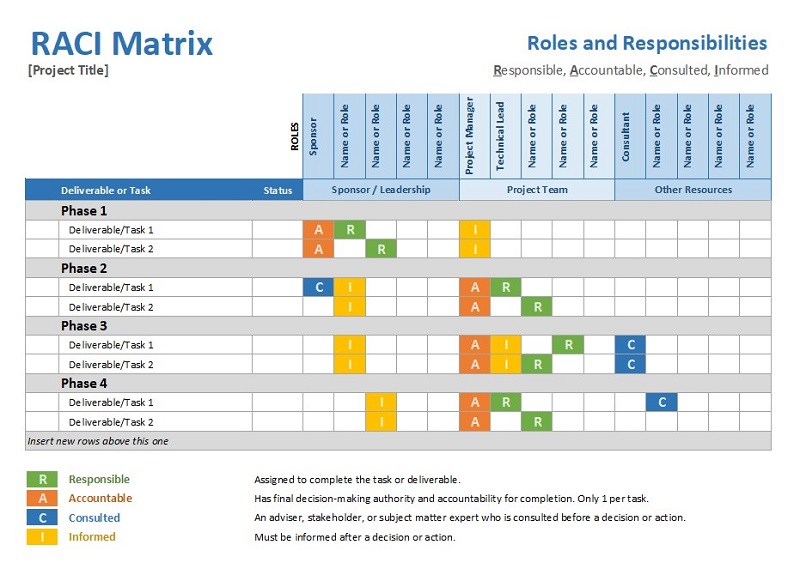
Responsibility Assignment Matrix Template
The Benefits of Using a RACI Chart
RACI charts are pivotal to efficient task administration and team collaboration, offering key advantages such as:
- Role Clarification: RACI charts delegate duties and responsibilities, removing ambiguity and ensuring each team member knows their role.
- Better Communication: By showing who should be consulted or informed for each task, RACI charts promote effective communication within the team.
- Preventing Task Overlaps and Gaps: RACI charts help identify tasks that might be overstaffed or overlooked, allowing proactive problem-solving to prevent confusion and duplicate work.
- Enhanced Accountability: By clearly marking who is accountable for each task, RACI charts foster a sense of ownership and accountability, boosting efficiency.
- Decision-Making Support: RACI charts assist in establishing decision-making processes by identifying who holds the final authority on different project aspects.
- Increased Efficiency: Through clear roles, better communication, and efficient decision-making, RACI charts help streamline projects, minimize delays, and improve outcomes.
RACI charts foster group collaboration, clear communication, and overall project success by ensuring everyone’s roles and responsibilities are well-defined, regardless of the project’s size or complexity.
Who Should Use a RACI Chart?
Various individuals and organizations can use RACI charts due to their versatility and ability to simplify complex tasks. Here’s a closer look at who can benefit from using a RACI chart:
- Project Managers: Project managers can use RACI charts to plan and execute projects by clarifying roles and responsibilities for all tasks. It allows project managers to visualize task allocation, ensuring everyone knows their responsibilities and nothing is overlooked.
- Team Leaders: Team leaders can use RACI charts to effectively allocate tasks to team members. It’s a helpful tool for leaders who want to optimize the productivity of their teams and ensure effective communication among members.
- Business Analysts: Business analysts often work with complex processes that involve various stakeholders. A RACI chart can help them clarify roles and responsibilities, ensuring all tasks are covered, and the process is well-coordinated.
- Organizations: Any organization dealing with a project or process involving various stakeholders can use a RACI chart. It includes corporations, non-profits, educational institutions, and government agencies. RACI charts can help streamline operations and improve efficiency by clarifying roles and responsibilities.
- Consultants: Consultants working with clients to improve their processes can use a RACI chart to identify and define roles and responsibilities, facilitating clearer understanding and better implementation.
- Event Planners: Event planning involves managing a plethora of tasks and roles. A RACI chart can help event planners organize tasks, delegate responsibilities, and ensure the smooth execution of the event.
Anyone responsible for managing a project, leading a team, or coordinating a complex process can benefit from using a RACI chart. It’s a versatile tool that can improve clarity, communication, and efficiency in various scenarios.
How a RACI Chart Works
Here’s a simplified explanation of how a RACI chart operates:
- Task and Stakeholder Identification: List all assignment tasks or deliverables and resolve all stakeholders. These form the foundations of your RACI matrix, with jobs as rows and stakeholders as columns.
- Role Assignment: For each assignment, assign the roles of Responsible (those doing the work), Accountable (someone answerable for job fulfillment), Consulted (those whose inputs are required), and Informed (those requiring updates on improvement).
- Review and Refinement: After setting roles, check the chart for gaps or overlaps in roles, confirming that all tasks are set and there’s no duplicated effort.
- Communication: Once finalized, It should be communicated with all stakeholders. It is a clear guide for decision-making and assignment execution throughout the task.
It visually outlines who does what in a project, thus providing clarity in roles and responsibilities and avoiding confusion.
When Should a RACI Chart be Used?
A RACI chart is a versatile tool that can be used in various scenarios:
- Project Planning: During project planning, a RACI chart helps assign responsibilities and tasks clearly, ensuring that every task has a designated owner.
- Project Execution: In complex projects, a RACI chart assists in tracking task completion and clarifying roles, if needed.
- Change Management: During change processes, RACI charts clarify who should be informed about changes, who will execute them, and who holds accountability for the results.
- Cross-Functional Collaboration: In scenarios where different teams or departments collaborate, a RACI chart prevents confusion and enhances coordination by defining roles across the board.
- Reorganizing Operations: Amid reorganization or restructuring, a RACI chart can delineate new roles and responsibilities, ensuring everyone is aware of their updated tasks and duties.
- Process Improvement: For evaluating and enhancing business processes, a RACI chart can outline who holds what role in each process, identifying areas for improvement and assigning responsibility for implementing changes.
RACI chart is crucial wherever there’s a need for clarity in roles and responsibilities, for a specific project, ongoing process, or a significant company-wide change. It’s an adaptable tool that ensures smooth operations and effective collaboration.

The content creator team at calipsotree.com is dedicated to making topics accessible to everyone, with over 9 years of experience in writing and breaking down complex concepts into easy-to-understand articles that answer readers’ financial questions.






